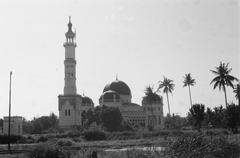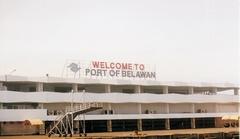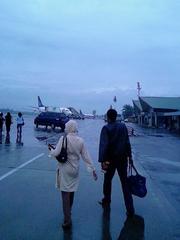Vihara Gunung Timur Medan Visitor Guide
Date: 17/08/2024
Introduction
Vihara Gunung Timur is the largest Taoist temple in Medan, Indonesia, and a prominent symbol of the city’s multicultural heritage. Established in the early 20th century, the temple has grown from a modest wooden structure to a sprawling cultural and religious complex covering approximately 5,000 square meters (Tribun Medan). Its architecture, community role, and vibrant festivals make it a must-visit destination for anyone interested in Medan’s diverse history and culture. This guide provides a thorough overview of Vihara Gunung Timur, including its history, architecture, cultural significance, visitor information, and practical travel tips.
Table of Contents
- Introduction
- History and Development
- Architectural Highlights
- Cultural and Social Significance
- Visitor Information
- Practical Travel Tips
- Nearby Attractions
- FAQ
- Conclusion
History and Development
Early Beginnings
Vihara Gunung Timur, also known as Dōng yuè guān (东岳观), was initially established in the 1930s to serve the religious needs of Medan’s Chinese community. The original temple was a simple wooden structure with a rumbia (palm leaf) roof, reflecting the humble beginnings of the community (Tribun Medan).
Community-Driven Transformation
As the Chinese-Indonesian population in Medan grew, so did support for the temple. Donations from local residents and benefactors enabled Vihara Gunung Timur to undergo significant renovations. The transformation included the construction of permanent structures, robust pillars engraved with Chinese characters, and the expansion of the temple grounds to accommodate more visitors and vehicles (Tribun Medan).
Architectural Highlights
Distinctive Chinese-Indonesian Design
Vihara Gunung Timur’s architecture is a harmonious blend of traditional Chinese and Indonesian influences. The entrance is flanked by ornate lion and dragon statues, symbolic protectors in Chinese culture (Travel Picks). The main hall is spacious, capable of accommodating hundreds for worship and ceremonies, and is adorned with vibrant murals, intricate woodwork, and statues of significant Taoist deities.
Main Prayer Hall and Altars
Inside the main hall, visitors can view statues of Dongyue Dadi (God of Mount Tai) and other deities, surrounded by offerings, candles, and incense burners. The layout and ornamentation reflect the temple’s role as both a religious sanctuary and a center for cultural gatherings (Wikipedia).
Seven-Storey Tower and Courtyard
The temple complex features a distinctive seven-storey tower in traditional Indonesian style, serving as a focal point for ceremonies. The expansive courtyard and gardens provide a tranquil setting for meditation, reflection, and community events (Discover Sumatra).
Cultural and Social Significance
Center of Community Life
Vihara Gunung Timur is far more than a place of worship; it is a social and cultural hub for the Chinese-Indonesian community. It hosts festivals such as Chinese New Year (Imlek), Cap Go Meh, the Lantern Festival, Qingming Festival, and Mid-Autumn Festival. These events feature traditional rituals, lion and dragon dances, and communal meals, reinforcing both religious devotion and cultural identity (Wikiwand).
Multicultural Neighborhood
Strategically located on Jalan Hang Tuah No. 16 in Madras Hulu, Medan Polonia, the temple is situated among other religious landmarks, including the Shri Mariamman Temple and Masjid Agung. This proximity highlights Medan’s unique multi-religious landscape and the spirit of tolerance among its diverse communities (Wikiwand).
Social Outreach and Education
The temple regularly organizes charity events such as free medical check-ups, blood donation drives, and food distributions, especially during major festivals. Cultural preservation initiatives, including traditional art classes, calligraphy workshops, and educational programs, ensure that younger generations remain connected to their heritage.
Visitor Information
Opening Hours
- Daily: 07:00 – 17:00 WIB
Admission
- Entrance Fee: Free (donations are encouraged to support maintenance and community programs)
Dress Code
- Modest attire is recommended as a sign of respect for the religious site.
Accessibility
- The temple grounds are generally accessible, but some areas may have steps or uneven surfaces. Wheelchair users are advised to contact the temple in advance for assistance.
Practical Travel Tips
- Best Time to Visit: Major festivals such as Chinese New Year offer a vibrant atmosphere but can be crowded. For a quieter visit, consider coming on weekdays or during non-festival periods.
- Getting There: The temple is easily accessible by car, taxi, or public transportation. On-site parking is available.
- Guided Tours: Some guided tours are available, offering in-depth insights into the temple’s history and features (Travel Picks).
Nearby Attractions
- Shri Mariamman Temple: Medan’s oldest Hindu temple, showcasing South Indian architecture and rituals.
- Masjid Agung: A major mosque that stands as a testament to the city’s Islamic heritage.
- Maimun Palace: A royal palace known for its unique Malay architecture.
- Tjong A Fie Mansion: A beautifully preserved historic mansion of a prominent Chinese businessman (What’s New Indonesia).
FAQ
What are the opening hours for Vihara Gunung Timur?
07:00–17:00 WIB daily.
Is there an entrance fee?
No, admission is free. Donations are appreciated.
How do I get to the temple?
The temple is located at Jalan Hang Tuah No. 16, Madras Hulu, Medan Polonia, and is easily accessible via car or public transportation.
Are there any dress codes?
Visitors are encouraged to dress modestly.
Can I take part in festivals or ceremonies?
Yes, visitors are welcome to observe and, where appropriate, participate in many cultural events.
Conclusion
Vihara Gunung Timur is a living testament to Medan’s multicultural spirit and the enduring traditions of its Chinese-Indonesian community. Its captivating architecture, vibrant festivals, and active community programs make it an essential destination for anyone seeking to experience the city’s rich cultural tapestry. Supported by the dedication and generosity of its community, the temple continues to flourish, preserving its heritage for future generations (Tribun Medan).
For more information, latest updates on festivals, and travel tips, download our mobile app Audiala, follow us on social media, or explore more related articles on our website.




